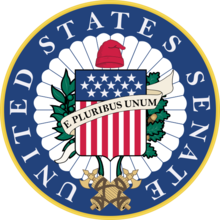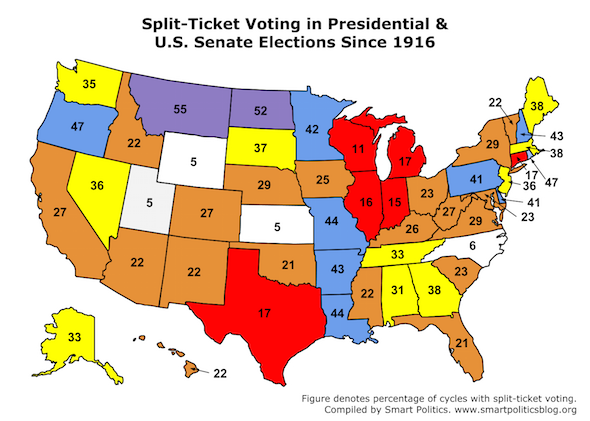Which States Are Likely to Split Their Presidential-US Senate Vote in 2016?
States have split their ballot only 29 percent of the time in presidential and U.S. Senate elections over the last century; 6% in NC, 11% in WI and 16% in IL (key 2016 battlegrounds)
 After holding the White House, the top electoral priority of Democrats in 2016 will be to take back control of the U.S. Senate.
After holding the White House, the top electoral priority of Democrats in 2016 will be to take back control of the U.S. Senate.
Much has already been written on the (comparatively) favorable map for the Democrats in this upcoming cycle – needing to defend only 10 of the 34 seats on the ballot as they attempt to net five seats.
Furthermore, Republicans have to defend more than a half-dozen purple or bluish states that Democrats have carried in at least the last two presidential elections: Wisconsin (seven in a row since 1988), Illinois (six), Pennsylvania (six), New Hampshire (three), Florida (two), Iowa (two), and Ohio (two).
Most of the Republican U.S. Senators from these states are expected to run for reelection, though possible presidential candidate Marco Rubio of Florida is still an unknown.
Democrats are also keeping a close eye on Richard Burr in North Carolina and Rand Paul’s (potentially open) seat in Kentucky.
The GOP, meanwhile, will take another serious look at dethroning Harry Reid in Nevada and has newfound optimism against Michael Bennet in Colorado after the defeat of his fellow delegation member Mark Udall in 2014.
Presuming Democrats are able to continue their presidential election streaks in the competitive states listed above, what are the odds voters in those states will also opt for the Democratic challenger in their U.S. Senate contests?
While incumbency and the quality of challengers for both offices are of course always key variables in helping to determine the likelihood of a seat flipping parties, in the vast majority of cases voters elect U.S. Senators from the same party of the presidential nominee to whom they give their Electoral College votes.
But there are nonetheless some interesting historical patterns as to which states split their vote in these presidential and U.S. Senate elections.
A Smart Politics study finds that since the onset of direct elections to the U.S. Senate a century ago, states have split their ballot in 29 percent of elections for president and U.S. Senate since 1916 with only two states doing so more than half of the time – Montana and North Dakota.
Overall, states have split their ballots in U.S. Senate and presidential elections in 251 of 862 elections over the last century.
Montana leads the nation with the highest rate at 55.6 percent, doing so in 10 of 18 cycles, including eight of the last 11 cycles in which both federal offices have been on the ballot.
The Treasure State has voted for a Republican presidential nominee and a Democrat for U.S. Senate during each of these 10 cycles: 1924 (Calvin Coolidge and Thomas Walsh), 1928 (Herbert Hoover and Burton Wheeler), 1952 (Dwight Eisenhower and Mike Mansfield), 1960 (Richard Nixon and Lee Metcalf), 1972 (Nixon and Metcalf), 1976 (Gerald Ford and John Melcher), 1984 (Ronald Reagan and Max Baucus), 1996 (Bob Dole and Baucus), 2008 (John McCain and Baucus), and 2012 (Mitt Romney and Jon Tester).
North Dakota has split its ticket 52.9 percent of the time (nine of 17 cycles).
Both Montana and North Dakota did so in 2012, when Mitt Romney won each state by double digits and Montana’s Jon Tester and North Dakota’s Heidi Heitkamp were victorious by 3.7 and 0.9 points respectively.
After Montana and North Dakota, Oregon has the next highest frequency of splitting its presidential and U.S. Senate ballots at 47.4 percent of the time followed by Rhode Island (41.1 percent), Louisiana and Missouri (44.4 percent), Arkansas and New Hampshire (43.8 percent), Minnesota (42.1 percent), and Delaware and Pennsylvania (41.2 percent).
On the other end of the scale, Kansas and Wyoming come in at just 5.6 percent followed by Utah (5.9 percent), North Carolina (6.3 percent), Wisconsin (11.8 percent), Indiana (15.8 percent), Illinois (16.7 percent), and Connecticut, Michigan, and Texas (17.6 percent).
Several states where the Democrats hope to pick up U.S. Senate seats in 2016 rarely split their vote in presidential elections.
That’s good news for the party if it believes Hillary Clinton – or whoever the party nominates for president – does in fact carry these states at the top of the ticket.
For example, North Carolina has split its vote for president and U.S. Senate in just one of 16 elections, or 6.3 percent of the time – the fourth lowest rate in the nation.
The only time the Tar Heel State split its vote was in 1968 when it helped elect Richard Nixon but voted Democrat Sam Ervin into the U.S. Senate for a fourth time.
For each of the last seven cycles both offices were on the ballot, North Carolina has voted into office nominees of the same party for president and U.S. Senator: 1972, 1980, 1984, 1992, 1996, 2004, and 2008.
Wisconsin, meanwhile, has only split its vote for the two offices in just two out of 17 cycles since 1916, or 11.8 percent of the time.
In 1940, the Badger State electorate voted for Franklin Roosevelt for a third consecutive term while reelecting Republican-turned-Progressive U.S. Senator Robert La Follette, Jr.
Wisconsinites also split their ballot in 1968 when they voted for Nixon but reelected Democrat Gaylord Nelson to a second term.
Wisconsin has elected candidates from the same party for president and U.S. Senate during each of the last seven cycles both were on the ballot: in 1976, 1980, 1988, 1992, 2000, 2004, and 2012.
Four other states where Democrats are eying pick-up opportunities have also split their vote for president and U.S. Senate a quarter of the time or less over the last century.
Illinois (3 of 18, 16.7 percent) last did so in 1984 (voting for Ronald Reagan and Democrat Paul Simon) as well as 1940 (Roosevelt and Republican C. Wayland Brooks in a special election) and 1980 (Reagan and Democrat Alan Dixon).
Florida (4 of 19, 21.1 percent) did so in 1928 (Herbert Hoover and Democrat Park Trammell), 1956 (Eisenhower and Democrat Park Trammell), 1992 (George H.W. Bush and Democrat Bob Graham), and 2000 (George W. Bush and Democrat Bill Nelson)
Ohio (4 of 17, 23.5 percent) last did so in 1988 (George H.W. Bush and Democrat Howard Metzenbaum) plus 1940 (Roosevelt and Republican Harold Burton), 1956 (Dwight Eisenhower and Democrat Frank Lausche), and 1980 (Reagan and Democrat John Glenn).
Iowa (4 of 16, 25.0 percent) last did so in 1992 (Bill Clinton and Republican Chuck Grassley) plus 1968 (Nixon and Democrat Harold Hughes), 1972 (Nixon and Democrat Dick Clark), and 1984 (Reagan and Democrat Tom Harkin). Iowa has thus split its ticket in four of the last eight cycles after not doing so once prior to 1968.
Kentucky, meanwhile, split its ballots in just five of 19 election cycles since 1916, or 26.3 percent of the time: in 1920 (James Cox and Republican Richard Ernst), 1952 (Adlai Stevenson and Republican John Cooper in a special election), 1972 (Nixon and Democrat Dee Huddleston), 1980 (Reagan and Democrat Wendell Ford), and 1996 (Clinton and Republican Mitch McConnell).
However, there are two battleground states in both presidential and U.S. Senate elections in 2016 that have been more prone to splitting their vote for these offices – New Hampshire and Pennsylvania – and that’s good news for Kelly Ayotte and Pat Toomey respectively if the presidential races in these states go to the Democratic nominee.
New Hampshire has split its ticket in seven out of 16 cycles over the last century (43.8 percent) including four of the last seven cycles: in 1932 (Hoover and Democrat Fred Brown), 1936 (Roosevelt and Republican Styles Bridges), 1944 (Roosevelt and Republican Charles Tobey), 1972 (Nixon and Democrat Thomas McIntyre), 1992 (Clinton and Republican Judd Gregg), 1996 (Clinton and Republican Bob Smith), and 2004 (John Kerry and Gregg).
Pennsylvania has done so in seven of 17 cycles, or 41.2 percent of the time: in 1956 (Eisenhower and Democrat Joseph Clark), 1964 (Lyndon Johnson and Republican Hugh Scott), 1968 (Hubert Humphrey and Republican Richard Schweiker), 1976 (Jimmy Carter and Republican John Heinz), 1992 (Clinton and Republican Arlen Specter), 2000 (Al Gore and Republican Rick Santorum), and 2004 (Kerry and Specter).
In battleground states where Republicans are eying pick-ups, Nevada has split its vote 36.8 percent of the time (seven of 19 cycles) with Colorado doing so in 27.8 percent of its elections (five of 18).
Follow Smart Politics on Twitter.

